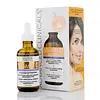What's inside
What's inside
 Key Ingredients
Key Ingredients

 Benefits
Benefits

 Concerns
Concerns

 Ingredients Side-by-side
Ingredients Side-by-side

Water
Skin ConditioningPEG-12 Dimethicone
Skin ConditioningAminopropyl Ascorbyl Phosphate
AntioxidantFerulic Acid
AntimicrobialLactic Acid
BufferingGlycolic Acid
BufferingGlycerin
HumectantPalmitoyl Tripeptide-1
Skin ConditioningPalmitoyl Tetrapeptide-7
Skin ConditioningAloe Barbadensis Leaf Juice Powder
Skin ConditioningTocopherol
AntioxidantHelianthus Annuus Extract
EmollientOryza Sativa Bran Extract
Skin ConditioningRosmarinus Officinalis Leaf Extract
AntimicrobialButylene Glycol
HumectantXanthan Gum
EmulsifyingPhenoxyethanol
PreservativeCaprylyl Glycol
EmollientHexylene Glycol
EmulsifyingEthylhexylglycerin
Skin ConditioningTetrasodium Glutamate Diacetate
Parfum
MaskingSodium Hydroxide
BufferingVanillin
MaskingMalonic Acid
BufferingCarbomer
Emulsion StabilisingSodium Lactate
BufferingPolysorbate 20
EmulsifyingLimonene
PerfumingLinalool
PerfumingCitronellol
PerfumingWater, PEG-12 Dimethicone, Aminopropyl Ascorbyl Phosphate, Ferulic Acid, Lactic Acid, Glycolic Acid, Glycerin, Palmitoyl Tripeptide-1, Palmitoyl Tetrapeptide-7, Aloe Barbadensis Leaf Juice Powder, Tocopherol, Helianthus Annuus Extract, Oryza Sativa Bran Extract, Rosmarinus Officinalis Leaf Extract, Butylene Glycol, Xanthan Gum, Phenoxyethanol, Caprylyl Glycol, Hexylene Glycol, Ethylhexylglycerin, Tetrasodium Glutamate Diacetate, Parfum, Sodium Hydroxide, Vanillin, Malonic Acid, Carbomer, Sodium Lactate, Polysorbate 20, Limonene, Linalool, Citronellol
C12-15 Alkyl Benzoate
AntimicrobialEthylhexyl Palmitate
EmollientCaprylic/Capric Triglyceride
MaskingGlycerin
HumectantWater
Skin ConditioningSucrose Laurate
EmollientOlea Europaea Fruit Oil
MaskingPersea Gratissima Oil
Skin ConditioningChlorella Protothecoides Oil
EmollientAlgae Exopolysaccharides
HumectantPrunus Amygdalus Dulcis Oil
Skin ConditioningVaccinium Myrtillus Seed Oil
Skin ConditioningRetinyl Palmitate
Skin ConditioningTocopheryl Acetate
AntioxidantCaprylyl Glycol
EmollientChlorphenesin
AntimicrobialPhenoxyethanol
PreservativeParfum
MaskingBenzyl Benzoate
AntimicrobialCI 77288
Cosmetic ColorantC12-15 Alkyl Benzoate, Ethylhexyl Palmitate, Caprylic/Capric Triglyceride, Glycerin, Water, Sucrose Laurate, Olea Europaea Fruit Oil, Persea Gratissima Oil, Chlorella Protothecoides Oil, Algae Exopolysaccharides, Prunus Amygdalus Dulcis Oil, Vaccinium Myrtillus Seed Oil, Retinyl Palmitate, Tocopheryl Acetate, Caprylyl Glycol, Chlorphenesin, Phenoxyethanol, Parfum, Benzyl Benzoate, CI 77288
Ingredients Explained
These ingredients are found in both products.
Ingredients higher up in an ingredient list are typically present in a larger amount.
Caprylyl Glycol is a humectant and emollient, meaning it attracts and preserves moisture.
It is a common ingredient in many products, especially those designed to hydrate skin. The primary benefits are retaining moisture, skin softening, and promoting a healthy skin barrier.
Though Caprylyl Glycol is an alcohol derived from fatty acids, it is not the kind that can dry out skin.
This ingredient is also used as a preservative to extend the life of products. It has slight antimicrobial properties.
Learn more about Caprylyl GlycolGlycerin is already naturally found in your skin. It helps moisturize and protect your skin.
A study from 2016 found glycerin to be more effective as a humectant than AHAs and hyaluronic acid.
As a humectant, it helps the skin stay hydrated by pulling moisture to your skin. The low molecular weight of glycerin allows it to pull moisture into the deeper layers of your skin.
Hydrated skin improves your skin barrier; Your skin barrier helps protect against irritants and bacteria.
Glycerin has also been found to have antimicrobial and antiviral properties. Due to these properties, glycerin is often used in wound and burn treatments.
In cosmetics, glycerin is usually derived from plants such as soybean or palm. However, it can also be sourced from animals, such as tallow or animal fat.
This ingredient is organic, colorless, odorless, and non-toxic.
Glycerin is the name for this ingredient in American English. British English uses Glycerol/Glycerine.
Learn more about GlycerinParfum is a catch-all term for an ingredient or more that is used to give a scent to products.
Also called "fragrance", this ingredient can be a blend of hundreds of chemicals or plant oils. This means every product with "fragrance" or "parfum" in the ingredients list is a different mixture.
For instance, Habanolide is a proprietary trade name for a specific aroma chemical. When used as a fragrance ingredient in cosmetics, most aroma chemicals fall under the broad labeling category of “FRAGRANCE” or “PARFUM” according to EU and US regulations.
The term 'parfum' or 'fragrance' is not regulated in many countries. In many cases, it is up to the brand to define this term.
For instance, many brands choose to label themselves as "fragrance-free" because they are not using synthetic fragrances. However, their products may still contain ingredients such as essential oils that are considered a fragrance by INCI standards.
One example is Calendula flower extract. Calendula is an essential oil that still imparts a scent or 'fragrance'.
Depending on the blend, the ingredients in the mixture can cause allergies and sensitivities on the skin. Some ingredients that are known EU allergens include linalool and citronellol.
Parfum can also be used to mask or cover an unpleasant scent.
The bottom line is: not all fragrances/parfum/ingredients are created equally. If you are worried about fragrances, we recommend taking a closer look at an ingredient. And of course, we always recommend speaking with a professional.
Learn more about ParfumPhenoxyethanol is a preservative that has germicide, antimicrobial, and aromatic properties. Studies show that phenoxyethanol can prevent microbial growth. By itself, it has a scent that is similar to that of a rose.
It's often used in formulations along with Caprylyl Glycol to preserve the shelf life of products.
Water. It's the most common cosmetic ingredient of all. You'll usually see it at the top of ingredient lists, meaning that it makes up the largest part of the product.
So why is it so popular? Water most often acts as a solvent - this means that it helps dissolve other ingredients into the formulation.
You'll also recognize water as that liquid we all need to stay alive. If you see this, drink a glass of water. Stay hydrated!
Learn more about Water